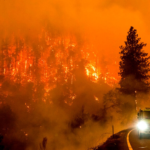A significant winter storm hit North Texas on Thursday and Friday, with snowfall totals varying greatly across the region. While some areas experienced heavy snow accumulation, others received much less than anticipated. This article breaks down the Dallas snowfall totals, detailing how much snow fell, where, and the impact it had on local residents.
Overview of Winter Storm Impact in North Texas – Dallas Snowfall
The winter storm that swept across North Texas caused a range of impacts, from slippery road conditions to travel disruptions. Residents living in northern counties saw the most substantial snowfalls, while those in southern Dallas experienced lighter snowfall than expected.
Northern Counties Experience Significant Accumulation
As of 4 a.m. Friday, areas to the north of Highway 182 in Cooke and Grayson counties reported significant snow accumulation. Gainesville, Sherman, and Bonham were among the areas with the most snowfall, each receiving more than 6 inches. The storm hit these regions the hardest, bringing the most impressive snow totals.

Dallas Snowfall Totals in Cooke, Grayson, and Surrounding Areas
In the counties of Cooke and Grayson, the snowfall was notably higher than in other parts of North Texas. Gainesville, Sherman, and Bonham all reported totals above 6 inches, making these areas the hardest-hit in the storm.
Dallas Snowfall Breakdown Across North Texas
In addition to the northern counties, other parts of North Texas, such as Wise, Denton, and Collin counties, saw snowfall totals ranging from 3 to 6 inches. Meanwhile, areas like Fort Worth and North Dallas experienced between 1 and 3 inches.
Areas with Less Than Expected Snowfall
Although the forecast initially suggested heavier snow for certain areas, those living south of Dallas received much less than anticipated. Some people saw less than an inch of snow, which led to varying experiences across the region.
Southern Dallas Receives Less Than an Inch
While the snowstorm delivered an impressive show in the northern parts of North Texas, southern Dallas saw a much lighter dusting of snow. Residents south of Dallas received less than an inch, which caused some disappointment for snow lovers hoping for more.
Weather Meteorologist Evan Andrews’ Insight
Weather Meteorologist Evan Andrews provided insight into the storm’s unpredictable nature. Andrews stated that the storm’s forecast was difficult to pin down, with some areas experiencing heavier precipitation, while others received less snow than expected.
“Some of you got that heavier precipitation [on Thursday]. Others were waiting for some overnight, and the precip overnight really never got going. We got a little bit of light snow on the backend but not a ton,” he said.
Thursday Snowfall Observations
On Thursday, much of the snow fell in the early hours of the day, with varying snowfall amounts across different parts of the region. By the time the snow was expected to continue overnight, many areas had already experienced changes in their snow totals for the day.
Friday Snowfall Expectations
By Friday morning, the storm had mostly passed, and the chance of further accumulation was minimal. Only a few light flakes were expected in the morning, but no significant snow was anticipated.
Light Snow on Friday Morning
Though a few light flakes were expected to fall on Friday morning, no further accumulation was anticipated. For many residents, the snow they saw on Thursday would remain the most notable snowfall of the storm.
Why Did Snowfall Totals Vary Across North Texas?
The variation in snowfall totals can be attributed to several meteorological factors, including geography, elevation, and the timing of precipitation. Northern areas with higher elevations typically saw more snow, while southern areas received lighter amounts.
The Role of Geography and Elevation
Geography and elevation play a significant role in how much snow falls in a particular area. Areas at higher elevations typically experience more precipitation, which explains the higher snowfall totals in northern counties like Cooke and Grayson.
Meteorological Factors Affecting Snowfall Distribution
The distribution of snow across North Texas was influenced by various meteorological factors, such as wind patterns and temperature variations. These factors resulted in uneven snowfall totals across the region.
Preparing for Future Winter Storms in Dallas
As North Texas continues to experience winter storms, it’s important for residents to prepare for future snowfalls. Being ready for sudden weather changes and knowing how to stay safe in icy conditions is essential, especially during peak winter months.
What to Expect in Upcoming Weather Patterns
Looking ahead, residents can expect colder temperatures and possible snow in the coming weeks. Winter storm warnings and advisories will likely continue to impact the region throughout the season.
FAQs on Dallas Snowfall Totals
How Much Snow Fell on Thursday and Friday in Dallas? On Thursday, snowfall totals varied, with areas north of Dallas receiving over 6 inches of snow, while south Dallas saw less than an inch.
Which Areas Got the Most Snowfall? The highest snowfall totals were reported in Gainesville, Sherman, and Bonham, where more than 6 inches of snow fell.
Will There Be More Snow Later? No additional significant snowfall is expected on Friday, although light flakes may fall in the morning.
How Does This Storm Compare to Previous Dallas Snowstorms? This storm brought substantial snowfall to some areas, while others received less than expected, making it unique compared to previous storms.
Is It Safe to Travel in North Texas After This Snowstorm? While snow accumulation has mostly stopped, icy conditions could still pose risks, especially in northern counties.
What Should I Do If I Encounter Snow and Ice on the Roads? If you encounter snow and ice while driving, reduce your speed, maintain a safe distance from other vehicles, and avoid sudden movements.
Conclusion: Recap of Dallas Snowfall Totals
The recent winter storm brought varying levels of snow across North Texas. While some areas received significant snow accumulation, others saw less than anticipated. As the weather continues to change, residents should stay informed and prepared for future snowstorms.






